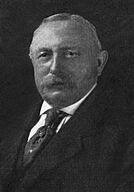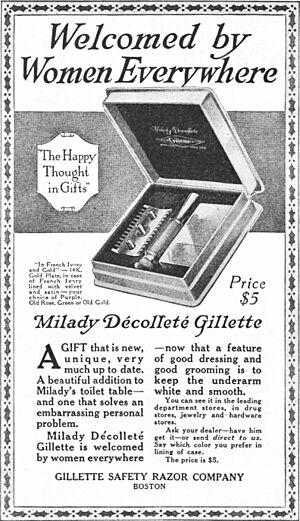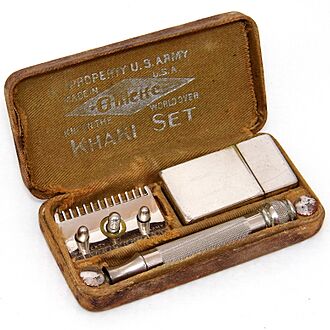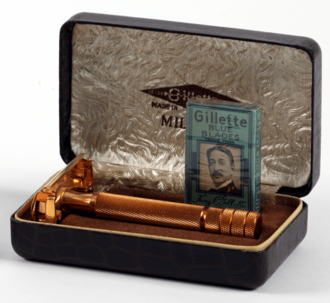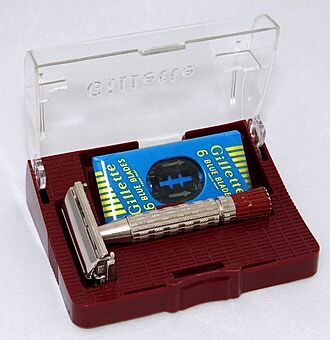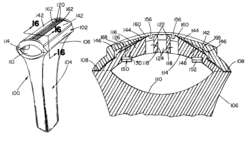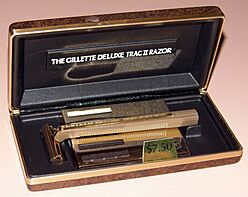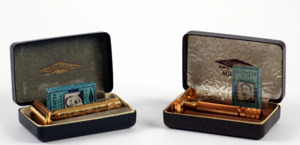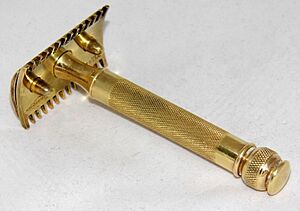Gillette facts for kids
 |
|
| Product type | Safety razors, shaving supplies, personal care products |
|---|---|
| Owner | Procter & Gamble |
| Country | Boston, Massachusetts, U.S. |
| Introduced | September 28, 1901 |
| Markets | Worldwide |
| Previous owners | The Gillette Company |
| Tagline | "The Best a Man Can Get" (1989–2019, 2023–present) "The Best Men Can Be" (2019–2023) |
Gillette is an American brand famous for its safety razors and other personal care products. These include shaving supplies. The brand is owned by a large company called Procter & Gamble (P&G). Gillette started in Boston, Massachusetts, USA.
It was once owned by "The Gillette Company." This company made many different products. In 2005, The Gillette Company joined with P&G. Gillette was founded by King C. Gillette in 1901. He started it to make safety razors.
After joining P&G, Gillette's parts became a unit called "Global Gillette." Later, in 2007, this unit was split up. Its brands and products were moved into P&G's other main groups. However, Gillette's research center and manufacturing plant in Boston still operate. They are known as "Gillette World Shaving Headquarters." Other brands like Braun and Oral-B also stayed with P&G.
Contents
The Story of Gillette
How it All Started
The idea for Gillette came from King Camp Gillette. He was a salesman and inventor in the late 1800s. He thought of a safety razor that used blades you could throw away. Back then, safety razors used blades that needed to be sharpened often.
Gillette's idea came from his mentor, William Painter. Painter invented the Crown cork, a bottle cap that could be thrown away. Painter told Gillette to invent something similar. Something that could be used once and then discarded.
Gillette had his idea in 1895. But it took six years to create a working model. He also needed drawings for the Patent Office. It was hard to find someone who could make blades from thin metal sheets. Finally, he found William Emery Nickerson. Nickerson was an MIT graduate with a chemistry degree.
Gillette and his team started The American Safety Razor Company on September 28, 1901. They had trouble getting money. But Gillette's friend, John Joyce, invested what was needed. Production began slowly in 1903. The next year, Nickerson built a new machine to make blades faster.
In its first year, the company sold 51 razors and 168 blades. The next year, sales jumped to 90,884 razors and 123,648 blades. The company changed its name to the Gillette Safety Razor Company in 1904. It quickly grew outside the United States. By 1906, Gillette had offices and plants in many countries. This included Canada, Mexico, and several European nations.
World War I and the 1920s
Before World War I, Gillette's sales grew slowly. Disposable razor blades were not yet very common. Many people still used straight razors or went to barbershops. This changed when the United States entered the war in 1917. Soldiers had to bring their own shaving kits. Gillette's small kit with disposable blades was very popular.
Gillette made special military cases for their razors. These cases had U.S. Army and Navy symbols. In 1917, the company sold 1.1 million razors.
In 1918, the U.S. military started giving Gillette shaving kits to every soldier. Gillette's sales grew to 3.5 million razors and 32 million blades. Millions of soldiers got used to shaving daily with Gillette razors. After the war, Gillette used this in their ads. They encouraged people to keep shaving every day.
Gillette's first razor patent was set to end in November 1921. To stay ahead of new competitors, Gillette launched the New Improved Gillette Safety Razor in 1921. They also started their "razor and blades" pricing plan. This plan is still used today. The New Improved razor sold for $5. The original razor was renamed "Old Type" and sold for $1. This made Gillette razors much more affordable. It helped the company sell many more blades.
From 1917 to 1925, Gillette's sales increased ten times. The company also grew overseas after the war. They opened a new plant near London and many offices in Europe and other parts of the world.
The 1930s and World War II
The Great Depression made things tough for Gillette. The company had fallen behind in blade technology. In 1932, Gillette apologized for lower blade quality. They stopped selling their Kroman blade and introduced the Blue Blade. This blade was initially called the Blue Super Blade. Gillette also tried selling an electric shaver, but it didn't sell well.
In 1938, Gillette introduced the Thin Blade. It was cheaper and lighter than the Blue Blade. During World War II, the Thin Blade became very popular. This was because people wanted low-cost products. Also, there was a shortage of carbon steel.
Starting in 1939, Gillette began spending a lot on advertising at sports events. Their ads during the World Series more than doubled sales. They later sponsored a radio show called Gillette Cavalcade of Sports. This show also moved to television later. It became famous for showing professional boxing matches.
Even though Gillette faced tough competition in the U.S. during the Depression, its overseas business helped a lot. By 1935, more than half of Gillette's earnings came from outside the U.S. In 1938, almost all of the company's earnings came from other countries. Gillette expanded into Latin America and built a new blade plant in London. By 1937, Gillette's factory in Berlin made 40% of Germany's blades.
World War II reduced Gillette's blade production. Many markets were closed. German and Japanese forces took over some of the company's plants. Gillette's factories in Boston and London were partly used to make weapons. In 1942, the War Production Board told Gillette to make razors and blades mainly for the U.S. military. By the end of the war, soldiers had received 12.5 million razors and 1.5 billion blades.
Gillette also helped the U.S. Army with secret missions. They made copies of German razor blades for spies. This helped spies keep their identities secret. The company also made razors that hid money and escape maps. They even made magnetic blades that prisoners of war could use as a compass.
After the War: Growth and New Products
After the war, Gillette quickly increased production. They updated their factories in the U.S. and England. They also opened new plants in other countries. Sales rose to $50 million in 1946. By 1947, Gillette sold a billion blades. By 1950, Gillette had 50% of the U.S. blade market.
In 1947, Gillette launched the Gillette Super Speed razor. With it came the Speed-pak blade dispenser. This dispenser let users slide a new blade into the razor without touching the sharp edge. It also had a place to store used blades.
Gillette also started making other products. In 1948, they bought The Toni Company, which made home permanent hair kits. Later, they added shampoos and hair sprays. In 1955, they bought Paper Mate, a company that made ballpoint pens. In 1960, they introduced Right Guard aerosol deodorant.
Television advertising was a big part of Gillette's growth after the war. By the mid-1950s, 85% of Gillette's ad money went to TV. They sponsored the World Series and TV shows like Arthur Godfrey and His Friends.
Gillette also wanted to grow in other countries. But the Cold War made it hard to enter many markets. More countries wanted local companies to own foreign businesses. Gillette built factories and distribution networks in these places. They hoped markets would open up later.
One example was an Iranian factory. It was one of Gillette's largest. But after the Iranian Revolution in 1979, Gillette had to leave the country. American businesses were seen as enemies by the new government.
New Blades and Competition
In 1960, Gillette introduced the Super Blue blade. This was their first blade with a special coating. It gave a much more comfortable shave. The Super Blue was very successful. By the end of 1961, Gillette had 90% of the double-edge blade market.
In 1962, Wilkinson Sword launched a new blade. It was made of stainless steel and had a coating. Users said it stayed sharp three times longer than Gillette's best blades. This surprised Gillette. Other rivals like Schick also released stainless steel blades.
However, Gillette had already patented the method for making coated stainless steel blades. So, Wilkinson Sword had to pay Gillette to use their method. Gillette waited to release its own stainless steel blades. They wanted to keep making money from the Super Blue. But they eventually launched the Gillette Stainless blade in August 1963. This was about a year after Wilkinson's blades. As a result, Gillette's share of the double-edge blade market dropped.
Two years later, Gillette released the Super Stainless blades. These were made from an improved steel. Gillette also introduced the Techmatic. This was a new razor that used a continuous roll of stainless blade in a plastic cartridge.
The success of the Super Blue blades showed that chemistry was becoming as important as metalwork for Gillette. After the Wilkinson challenge, Gillette's chairman, Carl Gilbert, increased spending on research and development. He encouraged more R&D in both the U.S. and England.
Trac II: The First Twin-Blade Razor
Gillette started working on its first twin-blade razor in 1964. A new employee, Norman C. Welsh, found that one blade could pull a whisker out. Then, a second blade could cut it even shorter before it went back into the skin. This was called the "hysteresis effect."
For six years, Welsh and his team worked on using this effect. They focused on a system called Atra. The Atra razor had two blades in a plastic cartridge. But it required a scrubbing motion to use.
Gillette's marketing team worried that people wouldn't like the new scrubbing motion. So, Gillette decided to focus on another twin-blade system called "Rex." This system did not need a new way to shave. The Rex project was successful. Gillette announced the first twin-blade razor, now called Trac II, in late 1971. The Trac II became very popular. It helped Gillette compete with Wilkinson Sword's new single-blade cartridges.
The Rise of Disposable Razors
In 1974, a French company called Société Bic introduced the world's first disposable razor. It sold well in Europe. Gillette quickly worked to create its own disposable razor. They designed a single-blade razor like Bic's. But they soon changed to a razor that was basically a Trac II cartridge molded into a blue plastic handle.
Gillette launched this disposable razor as the Good News in 1976. This was about a year before Bic's razor came to the United States. Gillette became the market leader. Good News was also successful in Europe and Latin America, where it was called Prestobarba.
In Latin America, Gillette used a strategy called cannibalization. They sold the razor in different ways. Along with the advertised Prestobarba, they also sold it under other names. These versions were cheaper and made from yellow plastic. They were not advertised as much. This strategy worked well. Other companies could not gain a strong position. Gillette then used this same strategy in Russia, Poland, and parts of Asia.
Even though Gillette kept its lead, disposable razors had higher production costs. Price competition also hurt the company's profits. By 1980, disposable razors made up more than 27% of global shaving sales.
John W. Symons, a Gillette director, changed the company's direction in Europe. He saw that disposables were hurting sales of more profitable cartridge razors. Symons reduced marketing for disposables in Europe. He also launched an ad campaign to make Gillette's cartridge razors more appealing. This new strategy, along with cutting costs, increased profits. By 1985, Gillette's profits in Europe were $96 million.
In 1980, Gillette introduced Atra (known as Contour in Europe). This was a twin-blade razor with a pivoting head. It became a best-seller in the U.S. and a market leader in Europe.
Company Changes and New Products
In 1984, Gillette bought Oral-B Laboratories, a dental care company. In 1986, Revlon Group tried to buy Gillette. Gillette rejected the offer. Other companies also tried to buy Gillette in the late 1980s.
In 1989, Warren Buffett's company, Berkshire Hathaway, bought $600 million worth of Gillette shares. Buffett joined Gillette's board. This helped reduce the chances of a takeover.
In 1989 and 1990, Gillette launched a new product called Sensor. They spent $175 million on marketing it in many countries.
The 1990s and the "Razor Wars"
In 1990, Gillette tried to buy parts of Wilkinson Sword. But the U.S. government stopped the sale. They wanted to prevent Gillette from having too much control of the razor market. Gillette already controlled about half of the U.S. market.
In 1992, Gillette launched the Series line of men's grooming products. These included shaving gels, deodorants, and skin-care items. The company's SensorExcel launched in Europe and Canada in 1993. It came to the U.S. in 1994. In 1996, Gillette launched new products for women and teenage boys. These included the SensorExcel for Women.
The "Razor Wars" began when Gillette launched the Gillette Mach3 in 1998. This was the first three-blade razor. It took five years to develop and had 35 patents. Gillette spent $300 million on marketing the Mach3. The Mach3 and its replacement blades cost 35% more than the SensorExcel. By 1999, Gillette was worth $43 billion.
In 2003, Schick-Wilkinson Sword introduced the Quattro. This was a four-blade shaving system. It increased their market share. Gillette claimed the Quattro copied their Mach3 patents. Gillette's efforts were not successful. But by mid-2005, Gillette still had about two-thirds of the global wet-razor market.
Procter & Gamble Buys Gillette
In 2005, Procter & Gamble announced plans to buy Gillette for over $50 billion. This made P&G the world's largest consumer products company. The deal was approved by the Federal Trade Commission.
Gillette launched the Fusion, the world's first 5-blade razor, in 2005–2006. This was Gillette's first major launch after P&G bought them. By 2010, the Fusion was the best-selling blade and razor brand worldwide. It reached $1 billion in yearly sales faster than any other P&G product.
Gillette also launched the Fusion ProSeries skincare line in 2010. This included facial scrubs, face washes, and moisturizers. In 2012, the Gillette Fusion ProGlide Styler for facial hair was introduced. Famous athletes and celebrities helped promote it.
In 2015, the company started a subscription service called Gillette Shave Club. They later sued Dollar Shave Club for patent issues. The lawsuit was dropped after Dollar Shave Club sued back.
In 2019, Gillette partnered with TerraCycle. They created a recycling program for blades, razors, and packaging from any brand. In 2020, Gillette promised to reduce new plastic use by 50% by 2030. They also aim for zero waste in all their plants.
Gillette Products Over Time
Double-Edged Safety Razors
The first safety razor with a new disposable blade went on sale in 1903. Gillette kept a small number of models until 1921. That's when the original Gillette patent ended. Before that, Gillette introduced a new razor design. It was sold at different prices with various cases. This included the popular "aristocrat" model.
Gillette continued to sell the original razor. But instead of $5, it was priced at $1. This made a Gillette razor affordable for everyone. In 1932, the Gillette Blue Blade was introduced. It was dipped in blue lacquer. It became one of the most famous blades in the world. In 1934, the "twist to open" (TTO) design was added. This made changing blades much easier. The razor head no longer had to be removed from the handle.
Razor handles kept improving for a closer shave. In 1947, the new TTO model, the "Super Speed", was launched. It was updated in 1955. Different versions were made for closer shaves. The closeness was shown by the color of the handle tip.
In 1955, the first adjustable razor was made. This allowed users to change how close the shave was. This model was made until 1988.
The Super Speed razor was redesigned again in 1966. It had a black handle. It was made until 1988. A similar model, the "Knack", had a longer plastic handle. It was made from 1966 to 1975. In Europe, the Knack was sold as "Slim Twist" and "G2000." A later version, "G1000," was made in England until 1998. A modern version of the Tech razor is still made and sold in some countries. It has a thin plastic handle.
Products No Longer Made
- Techmatic was a single-blade razor from the mid-1960s. It had a disposable cartridge with a razor band. You could move the band with a lever to get a fresh part. This was like having five blades.
- Trac II was the world's first two-blade razor, launched in 1971. Gillette said the second blade reduced how many strokes were needed and lessened skin irritation.
- Atra (also called Contour, Slalom, Vector in some places) came out in 1977. It was the first razor with a pivoting head. Gillette said this made it easier to shave necks.
- Good News! was the first disposable, double-blade razor, released in 1976.
- Custom Plus was a series of disposable razors with many types.
- Fusion Power Phenom was released in 2008. Other discontinued Fusion variants included the Fusion Power Gamer.
- Body was a 3-blade razor for men's body shaving. It was introduced in 2014 but stopped being made in 2018.
Current Products
- Gillette Sensor came out in 1990. It was designed by Dieter Rams. It was the first razor with spring-loaded blades. Gillette said the blades moved back into the cartridge when they touched skin. This helped prevent cuts and gave a closer shave. This line also includes the Sensor Excel, Sensor 3, and Sensor 3 Cool.
- Blue II is a line of disposable razors. It's a new name for the old Good News! brand. In Latin America, it's called Prestobarba. The Blue 3 is a cheaper three-blade disposable razor.
- Mach3 was the first three-blade razor, introduced in 1998. Gillette says it reduces irritation and needs fewer strokes. In 2016, P&G updated the Gillette Mach3 razor. It comes in disposable, sensitive, and "turbo" versions.
- Venus is a line of razors for women, created in 2000. Products include Venus Divine, Venus Vibrance, Venus Embrace, Venus Breeze, Venus Spa Breeze, and Venus ProSkin Moisture Rich.
- Gillette Fusion is a five-bladed razor released in 2006. The Fusion has five blades on the front and a single sixth blade on the back for trimming. Famous athletes like Roger Federer and Tiger Woods helped advertise it. Razors in this line include Fusion Power, Fusion ProGlide Shield, Fusion ProGlide, Fusion ProGlide Power, and Fusion ProGlide with FlexBall Technology. The ProGlide FlexBall has a handle that lets the razor head pivot.
- Gillette All-Purpose Styler, released in 2012, is a waterproof beard trimmer. It can cut four different lengths.
- Treo is the first razor made for caregivers to shave seniors and people with disabilities. It was introduced in 2017. Time magazine named it one of the best inventions of 2018.
- SkinGuard is a razor for people with sensitive skin. It was introduced in 2018–2019.
- In 2019, Gillette launched the first heated razor. It was designed to feel like a hot towel shave. Time magazine named it one of the best inventions of 2019.
- King C. Gillette Beard Care Line came out in May 2020. It's named after the company's founder. It offers beard care products like a beard kit, a safety razor, shave gel, beard and face wash, balm, and oil.
- Planet KIND Skincare Line launched in February 2021. It's a new sustainable shaving and skincare brand. It includes a razor, shave cream, moisturizer, and face wash. The razor is made from 60% recycled plastic. Refills have five blades that can last up to a month. Planet KIND works with TerraCycle to recycle the razor and blades.
Marketing and Advertising
Gillette first used its famous slogan, "The Best a Man Can Get," in a commercial in 1989. In 2024, singer Tom Grennan sang the song for a UK ad.
The company has sponsored Major League Baseball (MLB) and the Olympic Games. It also has naming rights to Gillette Stadium in Foxborough, Massachusetts. This stadium is home to the National Football League's New England Patriots and Major League Soccer's New England Revolution.
Many athletes have been sponsored by Gillette. These include Roger Federer, Tiger Woods, Derek Jeter, and Thierry Henry. Video game personality Dr Disrespect has also been a brand ambassador.
In November 2009, some people in Ireland wanted to boycott Gillette. This was because Gillette sponsored French soccer player Thierry Henry. He had a handball foul during a FIFA World Cup qualifying match. This led to France scoring a winning goal, which knocked Ireland out of the competition.
Since it opened in 2002, Gillette has had the naming rights to Gillette Stadium. The original agreement was until 2017. In 2010, P&G extended the deal until 2031.
Since the 1990s, Gillette has sent free razor samples to men on their 18th birthday. This is part of a "Welcome to Manhood" campaign. Sometimes, samples have accidentally been sent to people outside this age group.
In 2019, Gillette and Twitch teamed up to form the Gillette Gaming Alliance. They also had a "Bits for Blades" campaign. This gave Twitch Bits (a digital currency) to people who bought Gillette products online.
During 2020–2021, Gillette signed NFL players like Saquon Barkley and Tua Tagovailoa as brand ambassadors. Gillette became the jersey sponsor of the New England Revolution in 2025.
Gillette in Science and Music
In Science
In laser research, Gillette razor blades are sometimes used as a simple way to measure a laser beam's power. For example, a "four-Gillette laser" means it can burn through four blades.
In Music
An English rock band called The Kinks used a Gillette razor blade to create a special sound. Kinks member Dave Davies was not happy with his guitar sound. He bought a small amplifier. He then used a single-sided Gillette razor blade to cut around the speaker cone. This made the cone shredded but still attached. When he played, he loved the sound. This unique sound, made with a Gillette razor blade, became a key part of many early Kinks songs. These include "You Really Got Me" and "All Day and All of the Night".
See also
 In Spanish: Gillette (marca) para niños
In Spanish: Gillette (marca) para niños




